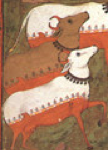What is Henna?
Henna is the Persian name for ‘Lawsonia Inermis’, a bushy flowering tree that was originally found in Australia, Asia and the Mediterranean coasts of Africa. Henna contains hennotannic acid which is a dye that comes together with the collagen in skin cells and keratin of fingernails and hair to leave behind a red stain. The henna flower is delicate and four-petaled with an abundance of slender and extended antennas bursting from the centre which range in colour from yellow to pink. The plant grows to about ten feet and the leaves are harvested immediately after the flowers appear. The henna plant releases an earthy scent once it has been powdered.
Traditions of Henna
Since early civilisation, the enchanting cosmetic product of henna has brought joy to many diverse cultures all around the world. Henna has often been associated with bringing love, good fortune and protecting against the evil eye. Studies on mummies dating back to 1200bc showed evidence of henna being used on the skin and hair of pharaohs.
Henna is frequently used in Islamic and Hindu cultures, particularly on brides. Beautiful and intricate designs are painted on to the bride’s hands and feet which often extends up to the palms and legs. Frequently symbols of fertility and love such as peacocks and hearts are integrated into the elaborate designs. The groom’s initials are occasionally hidden within these designs.
What is it used for?
Henna has been used for beautification purposes for many years, particularly in the Middle East and Far East. The most common use for henna is for dying hair and adorning skin due to its rich red colour and it’s also used for moisturising purposes. In Ancient Egypt, Cleopatra and Nerfertiti were known to have used it for prettification purposes. Moreover, since ancient times henna has been used in oil for perfumery.
Henna is also believed to have medical properties. The henna plant itself has cooling agents which has lead to it being used for bringing down a temperature from a fever and helping with heat fatigue. These properties also make it effective in protecting against sun burn. Henna is also used to treat scrapes and burns. Furthermore, it has been used to treat various skin rashes and conditions including athletes’ foot and ringworm. Henna is also known to be an effective pesticide and mildew.
In some countries, henna has been used extensively in the production of leather goods. It is used to adorn drum skins, for the general dying of leather as well as for colouring cloth. Additionally, it is known that henna was used by the Persians to dye the hooves and manes of their horses. Henna is also widely used in Morocco to decorate objects such as lamps and lanterns.





